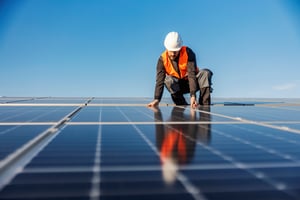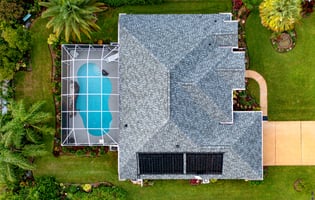Welcome to the land of endless sunshine, where the allure of turquoise waters meets the tranquility of rustic landscapes. Florida, renowned for its vibrant cities and world-famous attractions, also...
Oct / 14 / 2023
Emergency Solar Power Systems: Beyond Basic
With uncertainty in the realm of power supply, the need for a dependable and sustainable emergency backup power system has never been more apparent. A reliable backup solution is paramount, with frequent power outages arising from extreme weather events, grid failures, unforeseen disasters, and geopolitical instability.
- Smart Energy Management
- Energy Monitoring and Remote Control
- Expandable Battery Storage
- Hybrid Systems
- Grid-Independence
- Backup Generators
While traditional generators have long been the go-to option, there's a more innovative and eco-friendly alternative worth exploring – the emergency backup solar power system. In this article, we’ll go beyond the basics and unveil the potential of harnessing solar energy for emergency power needs, offering a resilient solution for the present and the future. Join us as we journey to discover the world of advanced emergency backup solar power systems.
Understanding Basic Emergency Solar Backup Systems
Basic solar backup energy systems are often a homeowner's initial foray into renewable energy and emergency power solutions. These systems typically consist of solar panels, an inverter, and a charge controller. They can significantly reduce your dependence on the grid during normal conditions, harnessing sunlight to generate clean electricity for immediate use or storage in batteries. These systems are a fantastic way to offset your electricity bills while reducing your carbon footprint.
However, it's important to recognize that basic solar backup energy systems have limitations. One of the most notable drawbacks is their inability to provide power when the sun is not shining. Cloudy days and nighttime render solar panels virtually ineffective. You'd need a reliable battery storage system to store excess solar energy during non-sunny hours to address this limitation.
Another significant constraint is that basic systems typically remain grid-tied, meaning they can't function independently during a power outage. For safety reasons, they often shut down to avoid sending electricity back into the grid, leaving your home in the dark when you need power the most. These limitations indicate the need for advanced features and enhancements, which we will explore in detail in the following sections.
Going Beyond Basic: Advanced Features and Components
Today, we have the advantage of some excellent advanced features and components for your emergency backup solar power system. Advanced backup solar power systems come equipped with smart energy management capabilities. These systems can intelligently allocate energy to prioritize essential appliances and circuits during an outage.
This ensures critical devices such as refrigerators, medical equipment, and lighting receive power while less crucial loads are temporarily disconnected. Such smart management not only maximizes the use of stored energy but also prolongs the life of your backup batteries.
Many advanced systems offer real-time energy monitoring and remote control via smartphone apps or web interfaces. This empowers homeowners to track their energy production and consumption and remotely manage their backup systems. It's a convenient way to stay informed about the health of your solar power setup and make adjustments as needed.
Advanced backup solar systems often allow for expandable battery storage to enhance your energy resilience. This means you can increase your energy storage capacity over time, adapting to your evolving energy needs and potentially becoming less reliant on the grid. Some advanced solar backup systems even offer hybrid capabilities by integrating other renewable energy sources like wind or hydropower. This hybrid approach ensures a more consistent power supply, especially in regions without abundant sunlight.
One of the most significant advancements is operating independently of the grid during power outages. These systems incorporate a backup inverter and a transfer switch that seamlessly disconnects your home from the grid when needed. This ensures continuous power availability even when the grid is down.
One of the most significant advancements is operating independently of the grid during power outages. These systems incorporate a backup inverter and a transfer switch that seamlessly disconnects your home from the grid when needed. This ensures continuous power availability even when the grid is down.
When sizing your solar backup system, it's essential to consider the capacity that best suits your needs. While a professional solar installer can offer tailored recommendations, let's delve into three popular system sizes to get an idea of what they can offer!
5kW Solar System with Battery Backup
A 5kW solar system is often suitable for smaller households with moderate energy consumption. Here's what you can expect:
Capacity: Typically, a 5kW system can produce around 20-25 kWh on a sunny day, depending on your location.
Battery Backup: Considering average consumption, a battery backup of around 10-15 kWh would be ideal for storing excess energy, ensuring power availability during non-sunny hours.
Daily Needs: This setup can comfortably power essential appliances like a refrigerator, some lights, and a TV, and charge devices like laptops and phones.
Footprint: This system usually requires about 20-30 square meters of roof space for the solar panels.
10kW Solar System with Battery Backup
A 10kW system is suitable for medium to large households with higher energy needs:
Capacity: On average, a 10kW system can produce around 40-50 kWh on a sunny day.
Battery Backup: A battery capacity of around 20-30 kWh would be recommended, capturing excess energy for use during the evening or cloudy days.
Daily Needs: This system can support more appliances, including air conditioning units, heating systems, and more electronics.
Footprint: Around 40-60 square meters of roof space would be required for the solar panels.
15kW Solar System with Battery Backup
Ideal for larger households or small commercial setups, the 15kW system offers an expansive capacity:
Capacity: A system can churn out around 60-75 kWh on a sunny day.
Battery Backup: A battery capacity of around 30-45 kWh is advised to ensure consistent power during downtime.
Daily Needs: It can easily handle multiple air conditioners, large heating systems, extensive lighting, and several electronics, making it perfect for households with high energy consumption or small businesses.
Footprint: This would require around 60-90 square meters of roof space for the panels
Sizing Your Solar Backup System
Sizing a backup system for solar panels involves determining the capacity of the battery storage system and other components to ensure that you have adequate power during an outage. Here are some of our tips when it comes to understanding what YOU need for your use depending on the size of your home and your energy requirements:
- Start by evaluating your household's energy needs. List essential appliances and devices you want to power during an outage and their power consumption (in watts) and estimated usage hours. This will give you a rough idea of your daily energy requirements.
- Multiply the power consumption of each device by the number of hours you expect to use it during an outage. Add these values to calculate your daily energy consumption in watt-hours (Wh).
- Multiply the power consumption of each device by the number of hours you expect to use it during an outage. Add these values to calculate your daily energy consumption in watt-hours (Wh).
- Remember that solar panels may only sometimes generate at their peak capacity due to weather conditions. It's essential to account for cloudy days when sizing your backup system. Consider adding a buffer by increasing your required energy storage capacity by 20-30% to ensure a reliable backup.
- Select a battery storage system with a capacity that can meet or exceed your calculated energy storage requirement. Battery capacity is typically measured in kilowatt-hours (kWh). Ensure the battery can discharge power at the rate you need to power your essential appliances.
- Your inverter should be able to handle the maximum power load of your essential appliances. Choose an inverter that can provide continuous power without overloading it.
- If your solar panels are not directly connected to the battery, you'll need a charge controller to regulate the energy flow from the panels to the battery. Ensure the charge controller can handle the maximum solar panel output.
- Ensure your solar panel system is compatible with the backup system and can efficiently charge the batteries. Consider the solar panel capacity and whether they can charge the batteries adequately during daylight hours.
- It's advisable to consult with a professional solar installer or electrician who can help you size your backup system accurately. They can assess your requirements, recommend the right components, and ensure a safe and efficient installation.
- Remember that solar backup systems require regular maintenance to ensure they operate effectively during outages. Periodically check the condition of your batteries and other components and replace them when necessary.
Sizing a backup system for your solar panels is a crucial step in ensuring you have a reliable source of power during power outages. It's important to strike a balance between your energy needs and budget, and consulting with experts can be invaluable in achieving the right system for your home.
Related Content: Complete Guide to Florida Solar
Smart energy management, expandable battery storage, grid independence, and hybrid capabilities are just a few of the advancements available, allowing you to customize your backup system to your unique needs. By carefully sizing your system, you can ensure that you have the right amount of power to keep your essential appliances and devices running during an outage.
With the right backup solar power system in place, you'll weather the storm easily and contribute to a cleaner and more resilient energy future. So, leap the basics and embrace a future where your energy needs are met and exceeded, all thanks to the sun's power.




